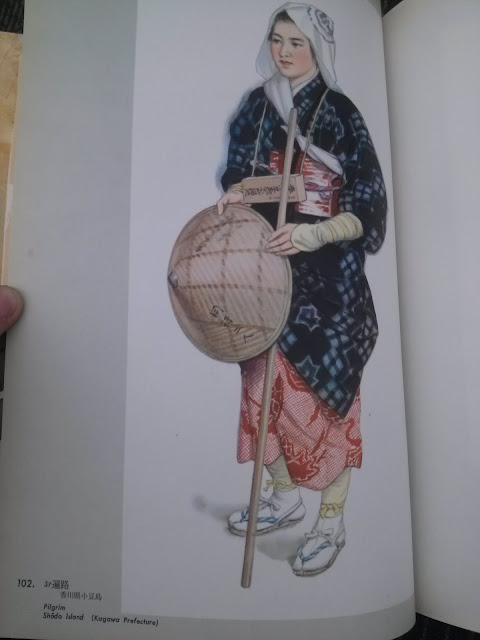Kimono-Lover.Blogspot.Ca
Saturday, April 30, 2016
Argh....
Yes, I feel bad. I started my "How to Make a Yukata" tutorial 2 years ago and I still haven't finished it. It's been so long now that my knowledge of waisai (Japanese sewing) has expanded dramatically and now I want to redo the whole thing from scratch... again.
Friday, January 22, 2016
Hakata Ori 博多織
Hakata Ori 博多織

Hakata Ori, or hakata weave, is a stripe-like pattern common on obi and cords.
I adore this weave. I think it's so pretty; I've always been so attracted to hakata obi's, thus I've decided to do this little appreciation post.
I adore this weave. I think it's so pretty; I've always been so attracted to hakata obi's, thus I've decided to do this little appreciation post.
Instead of going through the effort to rewriting my own post, I've posted my research below from various sites (so some stuff is repeated). I'm sorry, but re-writing everything into original prose seams a bit daunting to me :P (in other words, I'm lazy).
------------------------------------------------------------------------------------------------------------------------
From Immortal Geisha (slightly edited for this blog post)
Hakata Ori
Named for the region of Hakata-ku, Fukuoka, where it is primarily woven, Hakata is a distinctive thick silk textile, used primarily for obi, but also found on other items where a stiffer textile is necessary, such as handbags, zori, and especially datejime, where it's prized for its stiff texture and ability to hold in place without slipping. Hakata silk is very tightly woven, giving an appearance similar to grosgrain ribbon. When it's being tied, it should have a very distinctive "squeaking" noise as the ridges rub up against each other. This is not a flaw - it is a sign of a good true Hakata weave.Other common terms for hakata include hon-chikuzen, honchiku, hakata-ori, and kenjo-gara, when referring to the typical geometric design.
Seasonal Use, Exceptions & Pairings
As hakata is generally displayed in the kenjo-gara design, it is considered seasonless. It is always prudent to keep in mind the weight of the fabric - ro hakata can only be used in the summer, fukuro-sewn hakata only in awase seasons, but hakata weave is by default hitoe, and as an exception these can be used nearly year-round.Hakata obi are available in all standard modern obi sizes - hanhaba, nagoya, and fukuro.
Motif Variations
Kenjo-Gara 献上柄
(see below for meanings for this motif)While black and white is by far the most common colour combination for hakata weave, it is available in a multitude of other variations, several of which represent the five elements in Chinese mythology, or the five virtues of Confucianism.[2]
- Purple - Righteousness
- Green - Benevolence
- Red (also pink) - Propriety
- Yellow - Trust
- Blue - Wisdom
- Auspicious Nature
Motif in Literature & Other Usage
Geisha
Hakata was generally considered too casual and too "drab" for the average woman. However, as is their style, Geisha turned something mundane into something profoundly iki. While still technically too casual for most women, Geisha, especially of the Hakata district, are known to wear hakata fukuro obi with even the most formal kurotomesode outfits. There are also many examples of hakata darari obi for maiko.
--------------------------------------------------------------------------------------------------------------------------
From http://www.shop-japan.co.jp/english-boku/kenjou.html, however I've expanded, edited, and added some stuff.
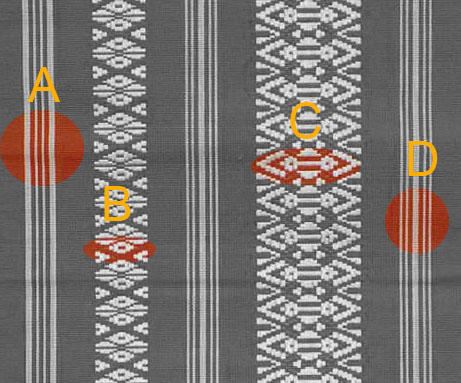
(source)
KENJOU 献上柄 design (shown above) is one of the most traditional design. It is originally from Hakata, Fukuoka Pref. in Kyushu, JAPAN.
Each woven stripe has a meaning:
A : Stripe (OYAKO JIMA = Parent and Child)
The thicker line is regarded as parent and thinner one is child.
"A" has thinner lines between thicker ones.
This means "parents are guarding their children"
B : Kaki (Hanadai or Hanazara)
This motif comes from Buddhist's prop. A flower base for Buddha and Hotokes.
You can see this line has roll- printing of the base.
華皿 はなざら (Hanazara)

C : Dokko
This is also Buddhist's prop motif. This is a prop Buddhist priest have.
This is also roll-printing design of the prop, Dokko.
独鈷 どっこ (Dokko)

D : Oyako Jima
This stripe is also Oyako jima, but see, this stripe means; children will guard their parents.
-------------------------------------------------------------------------------------------------------------------------------------------------------------
From JAPAN BLOG by AubergineFleur. Slightly edited for this blog post.All About Hakata Obi 博多帯のそれぞれ (英語で)
When someone refers to a Hakata obi 博多帯, usually what they mean is one specific weaving design of the Hakata obi called “kenjō” 独鈷, and also called “tokko” 独鈷, which resembles, and is so named for, the single-prong vajra Buddhist ritual implement, which looks kind of like <<=>>.

However there are many other designs woven into hakata obi, many floral rather than geometric, and the most ornate ones are prohibitively expensive.
* For more on the design and meaning see Bokunan-do's page on Kenjou Design.

“Hakata obi” is actually short for “hakata-ori no obi,” an obi of hakata weave. The Hakata obi is named for its place of origin in Fukuoka prefecture, where it is still woven today. The weaving technique was introduced to Japan the Katei era (1235-1238) by Mitsuda Yazaemon who went to Song-dynasty China and studied weaving techniques there. In its early period, it was a genuine form of Chinese weaving, referred to in Japan as “kara-ori” 唐織, “mainland-style weaving,” and was made of silk imported from China, although now the silk is produced in Japan.
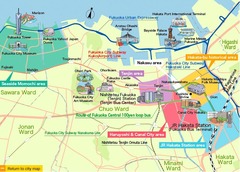
In 1600, the domain feudal lord, Kuroda Nagamasa, sent the Shogun as tribute hakata material in the kenjō design, and from thence on, the kenjō design became a hallmark of Hakata obi. The special quality of the hakata weave is the warp is used to make the design (unlike the Kyoto Nishijin weave 西陣織 which uses the weft), the threads are of varying thickness, and it makes a special silk noise called “kinu-nari” 絹鳴り. The silk material is also very firm and holds its shape well, so the tying of the bow of the obi does not come loose. Traditionally Hakata obi were hand-woven on a loom, but now they are often made on a jacquard loom, allowing for more gorgeous designs, some of which I believe are now computer generated.
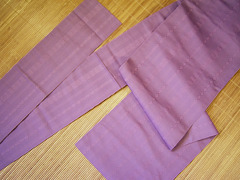
Hakata obi of the kenjō-tokko design are primarily made into a Nagoya obi or a hanhaba (half-width) size obi. Both may be either single-layered (hitoe) or double-layered (fukuro). There are also summer sha-gauze weaves in a kenjō-tokko design hakata obi, basically a loose weave, with a simple over-under pattern in the parts without design.
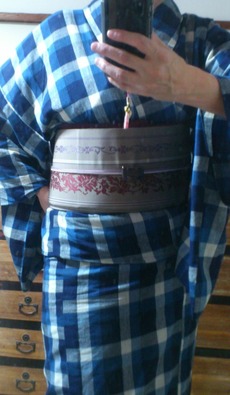 TPO for Hakata Obi TPO for Hakata Obi
Hakata obi of the kenjō design are fairly informal for the ordinary wearer. Based on observation, a Nagoya obi style can be worn with “fudangi” 普段着 everyday wear, everyday-wear tsumugi, and komon (simple all-over pattern kimono). An hanhaba hakata obi is even less formal, but can be worn with “fudangi” everyday wear, everyday-wear tsumugi, and yukatas.
<-- Mirror Image! 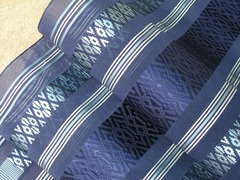
Sha-weave Nagoya hakata obi’s are often worn with ro-weave komon in the summer, and a sha-weave Hakata obi, whether Nagoya or hanhaba, dresses up a yukata. Maiko-san in Kyoto often wear sha-weave Hakata Nagoya obi’s with their yukatas in summer. One of my favorite Japanese bloggers on kimono wore a sha-gauze hakata Nagoya obi with her elegant Chikusen yukata last year, see Yukata Elegance: "Wa-bijin wo mezashite"
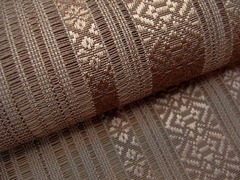
Likewise for the similar summer ra-gauze weave Hakata obi.
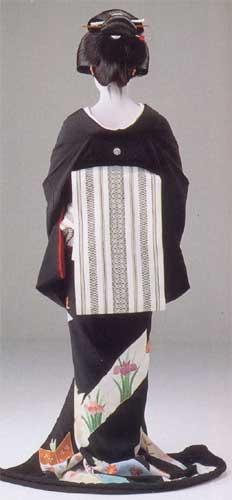
Hakata obi’s with the kenjō-tokko design are typically not worn with anything more formal than a komon, such as a tomesode, except by professionals such as Geiko-san (the Geisha of Kyoto), Japanese traditional-style dancers, and Noh performers. There are some extremely fancy hakata obi’s with a design other than kenjō-tokko that come in the formal fukuro-obi style. These are often worn with iro-muji kimonos.
Personally, I tend to wear kenjō-weave hakata obi’s (both hitoe and awase) often with yukata. This is because most of my hakata obi are the hanhaba size, so too informal to wear with much else. I do occasionally wear my non-kenjō design hanhaba hakata obi with my everyday-wear indigo tsumugi-kasuri kimono. I have become a bit of a Hakata-obi maniac, and have more than any sensible person needs. The one I wear most often is a dusty pinkish-purple (maroon) hassun Nagoya obi which I often wear with my indigo tsumugi-kasuri kimono, or just about anything else for that matter. As far as I can remember I only have two summer Hakata Nagoya obi, one is an egg-shell white sha-weave hakata obi which I wear with my summer ro komon or a high-end yukata, and another is a blue sha-weave hakata obi I wear with a high-end Chikusen yukata.
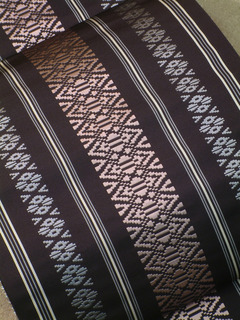 When to wear Hakata obi, seasonally –wise? When to wear Hakata obi, seasonally –wise?
Hakata obi’s are worn all year round. If you want to get really fancy, and have funds to buy the different types, you could wear a awase (double-layered) hakata obi with a awase (lined kimono) during the winter months from late September to early May, a hitoe (single-layer) hakata obi with a hitoe (unlined) kimono in the spring and fall months of mid-May to Mid-June and late August to late September, and a sha-gauze weave hakata obi with an “usumono” (sha, ro, hemp) kimono in the hottest part of summer from June to early September. Most hakata obi of the kenjō-tokko design, when made into a Nagoya obi, seem to typically be single-layer, and these in particular are often worn all year round, with the exception that the sha weave is only worn during the summer months. For more on what to wear when in general, see post “Kimono Seasons,” which has several kimono seasonal charts from kimono magazines.
-------------------------------------------------------------------------------------- Some Japanese information. I haven't translated it yet so I don't know if it's the same information as above. From here. 献上柄 |
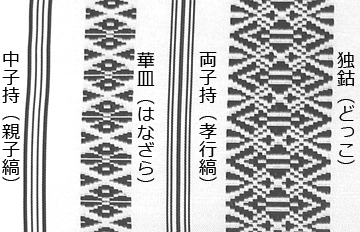
献上帯の謂れは古く、慶長5年(1600年)黒田長政が現在の福岡である筑前を領有するようになってから、毎年、幕府への献上品として博多織を送ったことに由来しています。献上柄は、一般に独鈷と華皿を文様化したもの、そして、その独鈷と華皿をそれぞれ両子持縞と中子持縞という2種類の縞柄によって挟んだ柄になっています。独鈷とは、仏像・不動明王などが手に持たれている仏具で、我々の悩みの元である煩悩を打ち砕くと伝えられています。華皿は、仏を供養する際の仏具で、華を盛る皿。縞柄は、太い線が親、細い線が子を現わしています。二人の子供を両親がかばうように囲んだ中子持縞は親子縞とも呼ばれ、一方、子供たちに囲まれ親に寄り添うように描かれた両子持縞は、孝行縞とも呼ばれています。幕府への忠誠を示し、神仏の御加護と家内安全・家内繁盛を願った縁起物として重宝されました。
----------------------------------------------------------------------------------------------------
Another Japanese link. "博多織について" here.
Monday, October 12, 2015
Hitoe Kimono Sewing Terminology
 |
| Hitoe Sewing Terminology Diagram (Female hitoe shown. Descriptions below.) |
1. 袖口 sodeguchi sleeve hole
2. 袖幅 sodehaba sleeve width
3. 袖丈 sodetake sleeve length
4. 袖口下 sodeguchishita lower sleeve edge
5. 丸み marumi rounded edge
6. 袖下 sodeshita sleeve bottom
7. 振り furi "Swing", sleeve edge (Not on male kimono)
8. 肩幅 katahaba shoulder width
9. 袖つけ sodetsuke sleeve seam
10. おくみ下がり okumisagari buried okumi length
11. 剣先 kensaki "Point of the Sword"
12. 身八つ口 miyatsuguchi underarm hole
13. 抱き幅 idakihaba "hugged" width
14. 掛衿 kakeeri collar guard
15. 衿中心 erichuushin collar center
16. 上衿幅 uwaerihaba upper collar width
17.ゆき yuki center to edge length
18.肩山 katayama highest part of the shoulder
19. 袖山 sodeyama highest part of the sleeve
20. 前袖 maesode sleeve front
21. 衿山 eriyama top collar edge
22. 衿 eri collar
23. 前身頃 maemigoro front panel, (下前 shitamae the panel tucked under when tied)
24. 合いつま幅 aizumahaba width were collar meets okumi
25. 下前幅 shitaerihaba bottom collar width
26. 後ろ身頃 ushiromigoro back body panel
27. おくみ okumi extension panels
28. 衿先 erisaki collar origin
29.衿下 erishita length between collar and skirt hem
30. おくみ okumi (表面 hyoumen outside surface)
31. おくみつけ okumitsuke okumi seam
32. 前幅 maehaba front width
33. 裾 suso skirt hem
34. おくみ幅okumihaba okumi width
35. 後ろ幅 ushirohaba back width
36. 脇縫い wakinui under arm seam
37. 前身頃 maemigoro front panel (上前 uwamae the outward panel when tied)
38. 前幅 maehaba front width
39. おくみ幅 okumihaba okumi width
40. つま先 tsumasaki hem "toe"
 |
| Hitoe Sewing Terminology Diagram - Inside Out Back View (Female hitoe shown. Descriptions below.) |
2. 掛け衿 kakeeri collar guard
3.肩当て kataate shoulder guard
4. くりこしあげ kurikoshiage tuck created for the collar gap (Not on male hitoe)
5. 背縫い senui back seam
6. いしき当て ishikiate kimono seat guard
7. 後ろ身頃 ushiromigoro back body panel (裏面 rimen underside surface)
8. 前身頃 meamigoro front body panel
9. おくみ okumi
10. 裾 suso skirt hem
11. 後ろ幅 ushirohaba back width
12. 前幅 maehaba front width
13. おくみ幅 okumihaba okumi width
Images scanned from 新きもの作り方全書. Translated by me (I tried my best but I am no expert. They may be inaccurate.)
Sunday, September 6, 2015
Concerning the name of geta
Being that I did some research for that geta post I previously did, I uncovered an interesting phenomenon; Oiran geta appear to have been incorrectly labeled in English and the error has spread everywhere.
In English, they are referred to as Koma geta. It's mentioned on the English Wikipedia page and repeated on several websites. However, when I translated the name into Japanese 駒下駄 (Koma Geta); only the smaller, classical two teeth geta come up in searches. On the Japanese Wikipedia page for 下駄 (geta), Oiran geta are referred to as 吉原下駄 (Yoshiwara Geta).
In fact, so far I haven't found any Japanese references to Oiran Geta as "Koma geta".
Below is a description on koma geta (from here):


In English, they are referred to as Koma geta. It's mentioned on the English Wikipedia page and repeated on several websites. However, when I translated the name into Japanese 駒下駄 (Koma Geta); only the smaller, classical two teeth geta come up in searches. On the Japanese Wikipedia page for 下駄 (geta), Oiran geta are referred to as 吉原下駄 (Yoshiwara Geta).
In fact, so far I haven't found any Japanese references to Oiran Geta as "Koma geta".
Below is a description on koma geta (from here):
"17世紀後期,貞享のころにできた下駄で,台も歯も1枚の板からくりぬいて作ったもの。歯は低い。駒(馬)のひづめの形に似ているのでこの名がある."
During the late 17th centery, around the Joukyou era, the platform and teeth were carved from one plank. The teeth were low, thus it's name resembles the word for horse (for the hooves) [Please note I translated this myself and my Japanese isn't all that great].The diagram below (from the page cited above) shows the low, two-teethed geta as koma geta.

In this next diagram, the large geta are called "Three-teeth Geta"

When I search for 駒下駄 (Koma geta), the following type of geta comes up.
Image from getaya.jp
Now I'm curious as to how and why that name got used for Oiran Geta in English in the first place. Not surprisingly, my attempts to follow citations on the internet have either sent me in circles or to dead ends, at least so far.
Japanese Womens Folk Costumes
Ie no Hikari Association (1960)
郷土の風俗
きょうどのふうぞく - [Native Customs]
郷土の風俗
きょうどのふうぞく - [Native Customs]
林唯一
家の光協会
Found this amazing book at the library! Wish I could sign it out but I couldn't, so I resorted to taking photos.
Saturday, July 25, 2015
Geta 下駄
Now let's take a quick break to talk about geta for your yukata! Nothing completes the yukata outfit than a cute pair of geta.
Let's start with the most common types.


二枚歯下駄
(Mimai-ha geta - Two teeth geta)

These are the classic style geta. The teeth come in varying heights. They are also referred to as komageta 駒下駄.
一本歯下駄
(Ipponba geta - Single tooth geta)

I would like to find out why these are a thing in all honesty. :P They look like trouble, but, apparently, they are not as difficult to walk in as they look they say (it's just standing still that's the tough part). These are sometimes called "tengu geta"(天狗の下駄).
おこぼ下駄

(Koppori Geta)
These are "maiko/geisha" style geta. They are also versions worn by small girls with full kimono garb during children's festivals. There are a couple of names for them, based on the sounds they make when walking; pokkuri ぽっくり and koppori こっぽり. I'm not sure how often these are worn causally but I have no problem finding these for sale (see link above for example). I have seen pictures of girls with yukata and furisode wearing them. I reeeeeally want to get a pair for myself.
And now for something really crazy...

These are oiran geta 花魁下駄, They're also referred to as Yoshiwara Geta 吉原下駄.
They're just nuts.
But .... if you type in oiran geta into Rakuten global market, you get some pretty rad stuff for sale.

Let's start with the most common types.
ピドヒール下駄
(Pidohiiru geta)

Woman's Pidohiiru Geta

Men's Pidohiiru Geta
These are a more modern style of geta that have become really popular. Generally, woman's have a rounder toe and use bright colours, while men's have a more squared toe with subdued colours. Generally. These are also sometimes referred to as Ukon Geta 右近 下駄.
二枚歯下駄
(Mimai-ha geta - Two teeth geta)
These are the classic style geta. The teeth come in varying heights. They are also referred to as komageta 駒下駄.
Now onto the less common ones...
一本歯下駄
(Ipponba geta - Single tooth geta)

I would like to find out why these are a thing in all honesty. :P They look like trouble, but, apparently, they are not as difficult to walk in as they look they say (it's just standing still that's the tough part). These are sometimes called "tengu geta"(天狗の下駄).
おこぼ下駄
(Okobo geta )
(Koppori Geta)
These are "maiko/geisha" style geta. They are also versions worn by small girls with full kimono garb during children's festivals. There are a couple of names for them, based on the sounds they make when walking; pokkuri ぽっくり and koppori こっぽり. I'm not sure how often these are worn causally but I have no problem finding these for sale (see link above for example). I have seen pictures of girls with yukata and furisode wearing them. I reeeeeally want to get a pair for myself.
And now for something really crazy...

These are oiran geta 花魁下駄, They're also referred to as Yoshiwara Geta 吉原下駄.
They're just nuts.
But .... if you type in oiran geta into Rakuten global market, you get some pretty rad stuff for sale.

I wants them.
Friday, July 24, 2015
Update-y-ness
I realized now why I neglected my blog for so long; I'm rather displeased with the photos I took to demonstrate the next part in my yukata tutorial. I said to myself "man, I should just draw some diagrams or something" and then BAM!!, a year passed.
But anyways, I plan to make another yukuta this summer so I'll make sure to get better sewing photos.
I really want to make it out of purple lace, with a teal obi.
And then I had this crazy idea.
I reeeealy like those white translucent "over kimonos" that are commonly seen on dancers (and similarly kimono dolls), like the ones seen below (I figured out it's called a karakoromo 唐衣) .


I wanna make something similar to wear over my purple and teal yukata.
But I dunno, maybe that might be bad? I don't know a lot about it, maybe it has quite a bit of religious significance. Maybe it's too formal to wear with a yukara. But damn, that would look cool.
But anyways, I plan to make another yukuta this summer so I'll make sure to get better sewing photos.
I really want to make it out of purple lace, with a teal obi.
And then I had this crazy idea.
I reeeealy like those white translucent "over kimonos" that are commonly seen on dancers (and similarly kimono dolls), like the ones seen below (I figured out it's called a karakoromo 唐衣) .


But I dunno, maybe that might be bad? I don't know a lot about it, maybe it has quite a bit of religious significance. Maybe it's too formal to wear with a yukara. But damn, that would look cool.
Subscribe to:
Posts (Atom)



